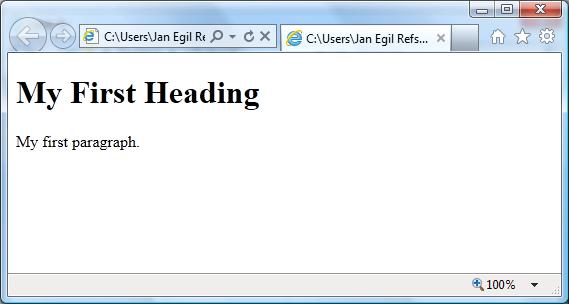Published on: 4/6/2014IST
HTML Introduction
HTML Example
<html>
<body>
<h1>My First Heading</h1>
<p>My first paragraph.</p>
</body>
</html>
Example Explained
- The DOCTYPE declaration defines the document type
- The text between <html> and </html> describes the web page
- The text between <body> and </body> is the visible page content
- The text between <h1> and </h1> is displayed as a heading
- The text between <p> and </p> is displayed as a paragraph
 |
The <!DOCTYPE html> declaration is the doctype for HTML5. |
|---|
What is HTML?
HTML is a language for describing web pages.
- HTML stands for Hyper Text Markup Language
- HTML is a markup language
- A markup language is a set of markup tags
- The tags describe document content
- HTML documents contain HTML tags and plain text
- HTML documents are also called web pages
HTML Tags
HTML markup tags are usually called HTML tags
- HTML tags are keywords (tag names) surrounded by angle brackets like <html>
- HTML tags normally come in pairs like <b> and </b>
- The first tag in a pair is the start tag, the second tag is the end tag
- The end tag is written like the start tag, with a forward slash before the tag name
- Start and end tags are also called opening tags and closing tags
HTML Elements
"HTML tags" and "HTML elements" are often used to describe the same thing.
But strictly speaking, an HTML element is everything between the start tag and the end tag, including the tags:
HTML Element:
Web Browsers
The purpose of a web browser (such as Google Chrome, Internet Explorer, Firefox, Safari) is to read HTML documents and display them as web pages.
The browser does not display the HTML tags, but uses the tags to determine how the content of the HTML page is to be presented/displayed to the user:

HTML Page Structure
Below is a visualization of an HTML page structure:
HTML Versions
Since the early days of the web, there have been many versions of HTML:
| Version | Year |
|---|---|
| HTML | 1991 |
| HTML+ | 1993 |
| HTML 2.0 | 1995 |
| HTML 3.2 | 1997 |
| HTML 4.01 | 1999 |
| XHTML | 2000 |
| HTML5 | 2012 |
The <!DOCTYPE> Declaration
The <!DOCTYPE> declaration helps the browser to display a web page correctly.
There are many different documents on the web, and a browser can only display an HTML page 100% correctly if it knows the HTML type and version used.
Common Declarations
HTML5
HTML 4.01
"http://www.w3.org/TR/html4/loose.dtd">
XHTML 1.0
"http://www.w3.org/TR/xhtml1/DTD/xhtml1-transitional.dtd">
4/6/2014 | | Permalink
